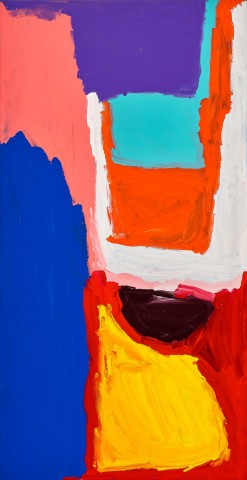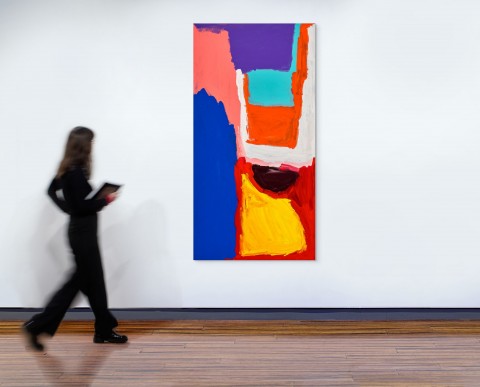MY FATHER'S COUNTRY / THUNDI BIG RIVER, 2008
MIRDIDINGKINGATHI JUWARNDA SALLY GABORI
synthetic polymer paint on linen
196.5 x 100.5 cm
bears inscription verso: artist's name, title, medium, Mornington Island Arts and Crafts cat. 3072-L-SG-0308 and Alcaston Gallery cat. AK19836
Mornington Island Arts and Crafts, Mornington Island, Queensland (stamped verso)
Alcaston Gallery, Melbourne (stamped on stretcher bar verso)
Private collection, Melbourne, acquired from the above in 2018
Kaiadilt Eyes – The Art of Seeing, Alcaston Gallery, Melbourne, 23 May – 16 June 2018, cat. 15
This work is accompanied by a certificate of authenticity from Alcaston Gallery.
Born by a creek in one of Australia’s most isolated areas, Mirdidingkingathi Juwarnda Sally Gabori grew up on Bentinck Island in Northern Queensland, part of the Kaiadilt people who used marine resources to fulfil all their needs and had very little outside contact. An intense drought followed by a tidal surge made the island uninhabitable, and at the age of 24 Mirdidingkingathi (meaning born at Mirdidingki River) Juwarnda (her totem, the dolphin) Sally Gabori and her family were persuaded to move to Mornington Island – a move that prompted feelings of huge loss for the Kaiadilt people. Gabori began her art career late in life, at the age of 85, however unlike many other Aboriginal language groups, the Kaiadilt did not have a tradition of mark making, whether on tools, objects or bark. Taking this cultural background into consideration, Gabori’s style is completely self-made, conjured from maps in her mind of Bentick Island and the country she loved.
My Father's Country, 2008 is a colourful, gestural and expressive tribute to the landscape and history of this country to the northern tip of Bentinck Island, her father’s country or Thundi. As with much of the Island, this area is characterised by a low-lying landscape with a river that runs into a large salt pan that fills in the wet season and is flanked my mangroves. Adjacent is a ridge of tall sandhills which line the north-eastern tip of the Island.1
1. McLean, B., ‘Dulka Warngiid; The Whole World’ in Mirdidingkingathi Juwarnda Sally Gabori Dulka Warngiid; Land of All, Queensland Art Gallery I Gallery of Modern Art, Brisbane, 2016, p. 22
CRISPIN GUTTERIDGE

